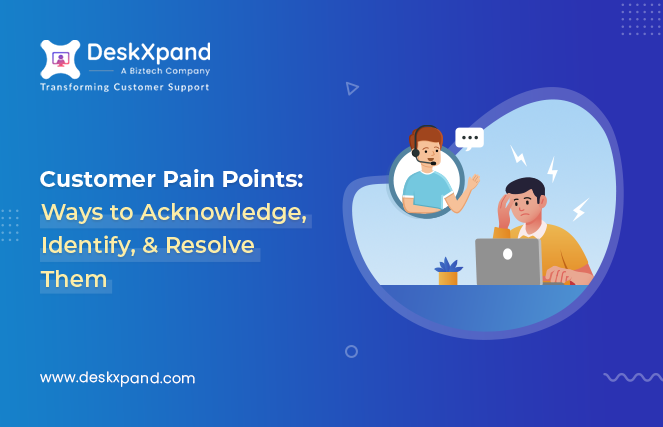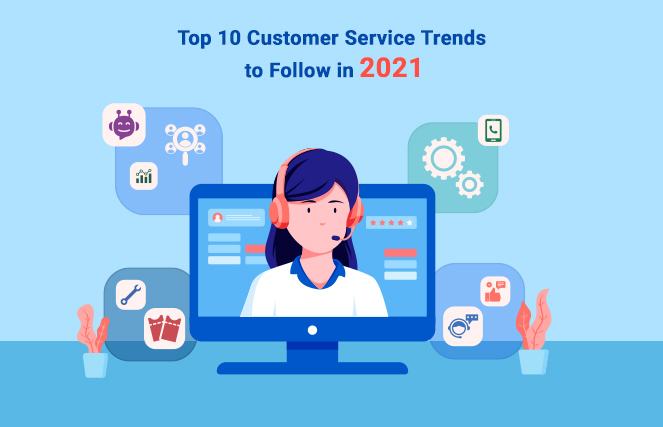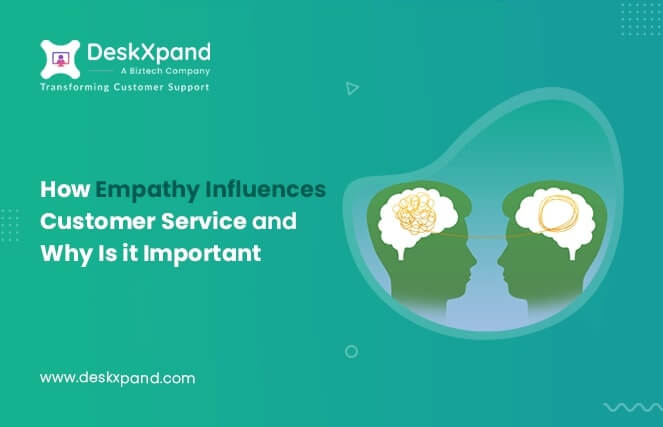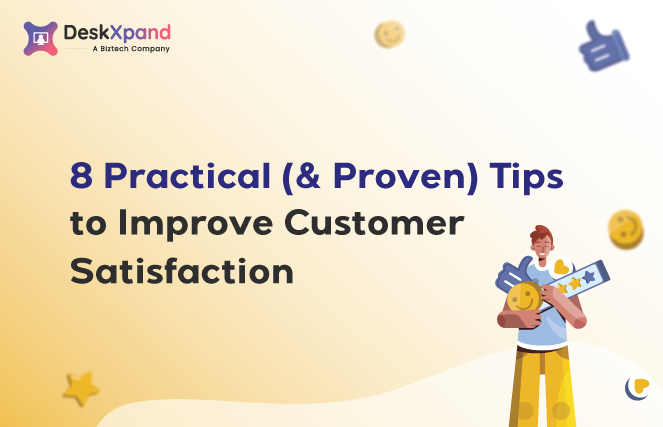Introduction
Why did the customer get lost?
Because he took the wrong churn!
This joke is funny for everyone except customer support managers and executives. Even the mention of a single wrong churn brings nightmares to stakeholders. The only thing worse than a customer who leaves is a customer who leaves without feedback. When a customer leaves without telling the brand why they’re leaving, a lot of things are lost:
You lose a customer.
You lose all the efforts and resources to retain that particular customer.
They leave you without giving feedback which means there’s a loophole in your support that you’re unaware of. And guess what? Maybe you’ll never find it!
Scary, isn’t it?
In the land of customer service, we often hear and talk about the importance of finding customers’ “pain points.” Brands should know the specific problems that customers face every day and issues that they may encounter while interacting with your brand. When you truly understand your customer’s pain points, you will know better how to position yourself. You’ll know how to communicate the unique benefits you can offer through your services.
However, discovering customers’ most pressing pain points is easier said than done. But it doesn’t have to be (and isn’t) as hard as you might think. So, if you’re wondering where to start, you’ve come to the right place.
In this article, I’ll walk you through the concept of customer pain points, how to find them and what to do to overcome them. So, if you too have that intense need to find a rational solution to this problem, tag along! I’ll talk about:
What Are Customer Pain Points?
Customer pain point is a specific problem that your current customer or prospective customers experience. Just think of customer pain points as problems, plain and simple. Like any problem, customer pain points are diverse and varied as your customers. However, not all customers will be aware of the pain point they’re experiencing. This can make marketing to these individuals difficult as you effectively have to help them realize the problem and convince them that your support team is capable of helping them solve it. You can think of customer pain points as simple problems, but they’re often grouped into several categories. Here are the four main types of customer pain points:
Types of Customer Pain Points
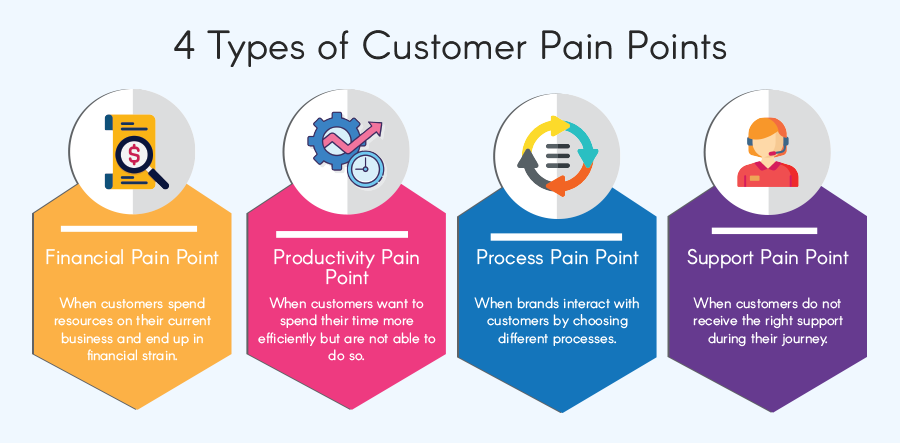
Four Types of Customer Pain Points
1. Financial Pain Points
Financial pain points mean that your customers are spending a large amount of money on their current business, which ends up with financial strain.
2. Productivity Pain Points
Sometimes prospective customers waste too much time using their current provider/solution and want to use their time more efficiently. Customers want to make the most of their time to avoid frustration. Some examples of productivity pain points are:
- Inconvenience in using the product
- Redundancy and friction in the buying process
Potential Solution
As a brand, you can convince your customers that your product is the key to saving their time and effort. Use product descriptions that explain how your product helps them practically.
3. Process Pain Points
It refers to how pain points in businesses interact with customers by choosing different methodologies and processes. This includes your customers wanting to improve their internal processes (like assigning leads to sales reps or nurturing low-priority leads.) These pain points include:
- Connecting to the right department
- Application submission
Potential Solution
Make sure that your team meets customer queries faster and persuades your prospects that your products/services are easier to use.
4. Support Pain Points
Customer support is one of the most important business functions. If customer support of any brand is improper, most of the crucial areas will be impacted. Your customers will not receive the support they need at critical stages of their journey. These queries would generally be product-related, and most of these customers will expect a prompt response. Some common support issues are:
- Late responses
- Lack of product knowledge
- The customer’s preferred channel of communication is not available
If not addressed correctly, support pain points impact customer retention and loyalty to a larger extent.
Potential Solution
One of the best ways to overcome this particular pain point is to help them in real-time with tools like live chat, co-browsing, and AI chatbots. Lastly, use the latest support tools and keep up with the trends.
See the situation from your customer’s perspective. DeskXpand’s customer support software can help you.
What Happens When Customer Pain Points are Not Addressed?
Sometimes brands fail to understand customer pain points. What happens then? Here’s what:
Top Side Effects of Bad Customer Service:
- A Damaged Reputation
- Leads Don’t Convert
- Your Customer Lifetime Value Drops
- You Lose Your Best Employees
- You Enter a Profit-Sucking Cycle
Customer support is arguably the most important thing for any business. Brands need to get it right! Excellent customer service is not just to entice customers, but it can overcome poor marketing, faults in your services, and loopholes in your support.
OTOH, it is incredibly difficult (nearly impossible) to replace bad customer support with even the most exceptional, delightful marketing. Of course, “good customer support” is often up for interpretation. It is normal for small mistakes to happen that are impossible to deal with. These mistakes are usually small bumps in the road and don’t constitute bad customer support. Following situations, however, are usually considered universally unacceptable:
- Poor attention to detail
- Long wait times and response times
- Support reps with a lack of experience and knowledge
- Unempathetic and impersonal interactions
Brands guilty of these traits often face negative consequences. Many of these are difficult to overcome and can lead to the company’s failure. The good news is that even the worst customer service habits can be corrected without detrimental damage to your brand. This can happen if you act quickly.
7 Effective Ways to Identify Customer Pain Points
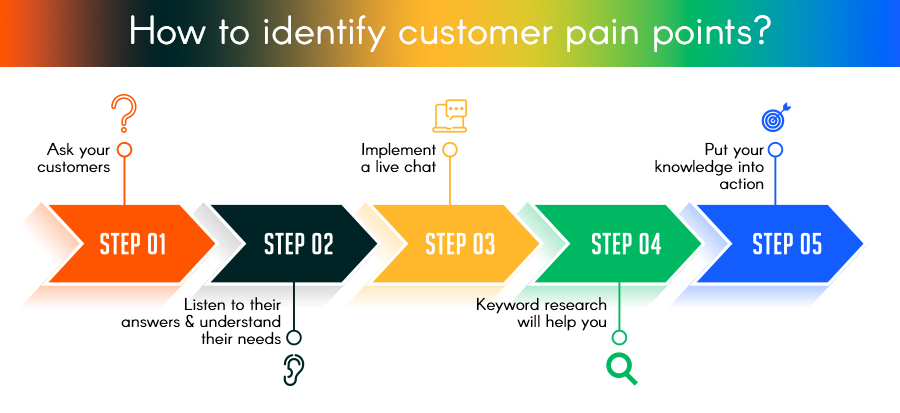
Identifying customer pain points is so crucial. Conducting an analysis is an essential stage for any business to improve the experience of different types of customers.
Here are some proven ways to figure out customer pain points:
1. Don’t Make It Complicated: Ask Them
Discovering customer pain points is not all that complex. After all, if a friend was feeling down, you wouldn’t hold a board meeting with the rest of your friends to find out the problem. You would simply ask them what’s wrong.
You should do the same thing with your customers. Speak with both your happy customers as well as unhappy customers. Ask questions that go deeper than “What do you think?” Ask questions like:
- What was your biggest challenge when you contacted us?
- Was the solution to your problem met instantly?
- What inconveniences did you have while finding a solution?
- How is it going now? And what can we do to improve your experience?
The more stories you can collect from your customers, the easier it will be to discover their pain points. You have to listen. It’s the only way to discover what your customers actually need said by David Richard.
2. Listen to Your Customers

You have to listen. It’s the only way to discover what your customers actually need. You can’t just focus on what you think they need and try to make their answers line up with your own preconceived notions. You have to accept that you don’t already know everything.
David Richard Petrillo
CEO, Perfect Image

Irrespective of how you collect your feedback, you have to take the listening approach. It all depends on how your process it. Learn from all this and apply it to make things better for your customers. This includes when you’re not listening in a face-to-face conversation. Online options (like forums, reviews, and social media comments) are all good ways to get the answers you need. People are usually comfortable giving feedback from beyond their screens than face-to-face.
3. Gather Customer Feedback
What better way to get insights into the challenges that your customers face than to know their own feedback? And it is not like these surveys are tough to create. With the data of the customers, you can easily get to know the history of your every individual customer, which can help you to create unique surveys.
These personalized surveys can help you identify the loopholes that already exist in your product or customer service processes. Once you identify these loopholes, it is also quite important to take action as soon as possible to avoid the negative experience caused to the customers. This way, with customer feedback, you can get better results with minimum effort.
4. Live Chat for The Win
You can effectively manage customer pain points by developing trust and confidence before offering solutions to customers. Adding a live chat to your support is a great way to find out customer demands and the issues that they’re facing. Here is how live chat helps discover customer pain points and offers effective solutions.
- You can enable instant connection with customers through live chat.
- You can immediately find out what they want and provide services that best suit their needs.
- Your agents can understand every issue to the best of their abilities and offer timely solutions.
5. Conduct a Market Research
Conducting a market research always should be an initial step before creating any strategies. This also proves to be correct for this scenario of identifying customer pain points. Initially analyzing the market can help you get proper understanding of what customers expect from your business. It also helps you understand your competition better.
For example, one of your competitors has created a product and has been selling it in the market for the last 2 years. But there is an issue that is faced by the customers who are using your competitor’s product. Now, if you want to launch a similar product in the market, with competitor analysis, you will learn about this loophole. And you will also learn how it has become a pain point for the customers.
So, while creating such a product, you will make sure that you do not repeat the same mistake. And you can also ensure that your customers are delighted with your product. This way, competitor analysis helps you to understand customer pain points and also helps you to get an edge over your competitors.
6. Analyze Customer Data
As they say, data does not lie. And many businesses rely on this data while taking crucial decisions. When in the process of identifying customer pain points, you must keep the data as close to you as you can. At every point, the data is what will make your life easy and will help you to take crucial decisions.
For example, let’s say you run an eCommerce store. Your eCommerce store is visited by a lot of customers but only a few are purchasing your products. In such situations, you can analyze the data to find out the loophole. You can know at what point in the whole purchasing process your customers leave without making any purchase. The data will show you exactly whether customers are leaving from a product page, checkout page, etc.
Once you know, which area needs improvement, it becomes comparatively easy to make the changes. Also, analyzing customer data can help you personalize your offerings by gaining insights into the past purchases of every individual customer. This way, you can also tackle the expectations of the customers of treating every individual customer as a unique one.
7. Check Out Online Reviews
According to a research, only 1 in 26 customers will tell a business about their negative experience. This shows amongst the pool of many customers there are only a few you care to reach out to. Businesses that want to enhance their customer experience and their offering, must consider these customers as an opportunity to get better.
Customers might directly reach out via email, call, etc. or else they can select an indirect path such as online reviews. Instead of reaching out they might write an online review for your products that they have used. These reviews can be of both type: positive and negative.
Positive ones are fine, they are all filled with praise. The real ones to look out for are the negatives ones. As these are messages (reviews) written to you by the customers regarding their pain points. So, as a business, you must focus on handling these negative reviews properly.
7 Tips to Address Customer’s Pain Points
Once you identify pain points, you can determine solutions for your prospects. This is an incredible tool to leverage as a customer support executive. Here are seven tips to start positioning in this way:
1. Make it Easy to Get Help
The first step to effective customer service is to make sure that customers are able to reach out to you easily. Let your customers know at what channels you offer customer service so that they do not waste their efforts trying to connect with you via a channel you are not available on.
2. Keep an Empathic Tone While Addressing the Customers
This is a psychological technique that all customer support professionals should practice. It can take you a long way in building trust with your prospect.
If you use their language and terminology, you can show your customers that you’re taking them seriously. This also portrays that you care about serving an empathetic response.
3. Start Using the Right Software
Customer service is a hectic task, but it becomes a lot easier once you start using the right software. It is packed with the most helpful and power-packed features, which not only simplify your service processes but also enhance your service department’s productivity and efficiency.
The right software offers features such as ticket management, omnichannel support, self-service, analytics, canned responses, live chat, customization, automation, etc. All these features speed up the resolution process and help agents to do more in less time. Hence, having the right software can be the difference between high-quality customer service and mediocre one.
4. Right Agent to Solve Relevant Queries
The main part of your strategy to address customers’ pain points should be that the queries must be diverted to the right agent.
If the right agent solves the query, the resolution rate will also improve. There is little point in making customers spend time with agents who cannot ink a deal.
5. Follow Up with Customer Complaints
When a customer takes the time to voice their concerns or dissatisfaction, it indicates that something has gone wrong in their experience with the product or service. By promptly acknowledging and following up on these complaints, businesses showcase their commitment to customer satisfaction. This proactive approach allows them to gain valuable insights into the specific pain points faced by customers.
By analyzing patterns and common issues in complaints, companies can identify recurring problems and prioritize improvements in their offerings. Engaging with dissatisfied customers also presents an opportunity to rebuild trust and loyalty. Not only does addressing complaints lead to more satisfied customers, but it also enables businesses to refine their processes, products, and services to better meet customer needs, ultimately driving long-term success.
6. Keep Up with the Latest Support Trends
A significant part of addressing customer pain point involves keeping up with the latest trends. This is because customer support is becoming more and more tech-oriented. New trends will help you solve those customer pain points. The key to lucrative customer support strategies lies in combining the latest tools, trends, collaboration, and workflows. When you keep yourself updated with the trends of industry standards, you’ll be able to serve your customer better. And your brand tends to become authentic.
A single data point can help teams work together by realizing the rising trends and roadblocks and then solving them or benefiting from them. Only the right tools will help you bring your data and strategies together. Try DeskXpand’s customer service analytics features and see how analytics can work in real-time.
Start Your Free Trial Now
7. Optimize customer journeys
As you build trust with your customers and listen to their perspectives, you must personalize the solution for their specific needs. Tell customers about the detailed features that’ll speak to their problems if your product serves multiple purposes.
Listen to your customer’s pain points while asking for information, and it’ll be easier to make your pitch meet everybody’s requirements. Customer support is all about empathy. To retain more customers and become as helpful as possible, start asking the right questions to the right customers.
7 Common Customer Pain Points (and How to Resolve Them)
As a brand, when you have a fair idea about their customer pain points, it becomes easier to approach them in the right manner. By using the right tools and tech, you can deliver a consistent experience across customer touchpoints. I have narrowed down some common client pain points that brands usually face:
1. Delayed Support Response
Nobody likes waiting in long queues to get their queries solved. Your customers are already dealing with the problem. At this point, even the thought of waiting would frustrate the customers. Besides, unsatisfied customers are more likely to share their experience with bad word of mouth. Here is the solution to overcome this problem:
Solution: To address delayed responses in customer support and ensure a seamless customer experience, you must closely monitor response times and identify areas for improvement. Also, set clear expectations from service agents so that they can prioritize their tasks properly. Additionally, you can start leveraging automated responses and chatbots to stay on top of customer queries and provide instant assistance for common concerns.
2. Unavailability of the Support Team
This is perhaps the biggest concern for most brands. The unavailability of your support team when customers need them the most is as haunting as it sounds. Maybe all your agents are busy, and they have queries piled up for weeks. Maybe your customer wants a solution in the middle of the night when you and your teams are sleeping. But its an issue that you need to sort out as fast as you can. Because their are brands that offer customers 24/7 customer support consistently.
Solution: To tackle the issue of the unavailability of the support team, you must optimize your support team’s working hours to cover peak customer demand and, if needed, expand your support team to provide coverage during extended hours or in different time zones. In cases where 24/7 support is essential, you can also employ remote teams or outsourced support to maintain round-the-clock availability.
3. Not Working on Negative Customer Feedback
Not working on negative customer feedback is considered a customer pain point because it leaves customers feeling unheard and undervalued. When customers take the time to provide feedback, especially if it highlights issues or concerns, they expect a response and action from the business. Ignoring or neglecting negative feedback can lead to frustration and a sense of being neglected. Customers may feel that their opinions are disregarded, which can result in them switching to your competitors or, even worse, sharing their negative experiences with others, potentially damaging the business’s reputation.
Solution: To resolve this pain point and improve customer satisfaction, businesses should adopt a proactive and customer-centric approach to negative feedback. By promptly acknowledging the feedback, showing genuine empathy, and taking concrete actions to address the issues, businesses can demonstrate their commitment to their customers and build a sense of trust and loyalty.
4. Lack of Adequate Knowledge of the Agents
The lack of adequate knowledge among customer service agents hinders the resolution of customer inquiries and concerns effectively. When customers reach out to a company for assistance, they expect to interact with knowledgeable representatives who can provide accurate and helpful information. If agents are unfamiliar with the products, services, or company policies, it leads to frustrating experiences for customers. Customers may need to repeat their issues, be transferred multiple times, or receive incorrect information, resulting in wasted time and increased frustration. Moreover, customers might perceive the company as unprofessional and indifferent to their needs, eroding trust and loyalty.
Solution: To resolve this pain point, businesses should invest in comprehensive and ongoing training for their customer service agents. This training should cover all aspects of the company’s offerings, policies, and common customer issues. Providing agents with easy access to a centralized knowledge base can also help them quickly find accurate information during interactions with customers. Additionally, encouraging a culture of continuous learning and knowledge sharing among agents can further enhance their expertise. Regular evaluations and performance feedback can ensure that agents stay up-to-date with the latest information and deliver consistent, high-quality service.
Start Your Free Trial
5. Inconsistency Between Channels
Inconsistency between channels is a significant customer pain point because it disrupts the seamless and unified experience that customers expect when interacting with a company. In today’s omnichannel world, customers may engage with a business through various touchpoints such as the website, social media, email, phone, or in-person interactions. Not offering omnichannel support might hamper customer trust and confidence in the company, as they may question the reliability and competence of the business.
Solution: To resolve this pain point, businesses need to focus on achieving channel consistency. Establishing clear and consistent communication guidelines also helps ensure that messaging is uniform across all channels. Integrating different communication channels allows for seamless collaboration. Regular monitoring and analysis of customer feedback and touchpoints can provide valuable insights into areas where inconsistency persists, enabling businesses to make necessary improvements and deliver a cohesive and consistent Omnichannel customer experience.
6. Rude Behavior of Support Representatives
The rude behavior of service agents directly impacts the customer’s experience and perception of the company. Customers expect to be treated with respect, empathy, and professionalism, but rude behavior sends out the wrong message. Behavior such as negative language, impatience, or a lack of courtesy, not only fails to address the customer’s concern but also leaves them feeling undervalued and frustrated.
Solution: To resolve this pain point, businesses must prioritize a culture of respect and empathy among their service agents. Agents should focus on effective communication, active listening, and handling difficult situations with patience and understanding. Emphasizing the importance of treating customers with respect, regardless of the nature of the inquiry, is essential. Regular feedback and coaching sessions can also help identify areas for improvement and encourage service agents to consistently deliver positive customer experiences.
7. Absence of Relevant Information
When customers reach out to a company for support or make purchasing decisions, they expect to find accurate and up-to-date information readily available. If a company’s website, product descriptions, or customer service agents lack the relevant details customers seek, it leads to frustration and inefficiency. Customers may need to spend more time searching for information or have to contact service agents multiple times, resulting in a poor experience. This lack of information might also lead to misunderstandings or incorrect choices.
Solution: To resolve this pain point, businesses should prioritize information management and ensure that all relevant details are readily accessible to customers. This can be achieved by maintaining a comprehensive and user-friendly website with clear product/service descriptions, frequently asked questions (FAQs), and helpful guides. Regularly updating and reviewing the information to keep it accurate and current is also essential.
Address Customer Pain Points with The Right Tools
Only the right tools can help you get through and improve your customer pain points. Having a customer-focused solution shouldn’t just be an aspirational goal. It is the new norm! I am sure that the above-mentioned strategies will help you achieve your retention and support goals.
Investing in the latest customer service tools and techniques to lead your brand through these strategies would be judicious. After intense research on industry trends, our functional experts and developers built DeskXpand with all the trending features and solutions. Find out how DeskXpand works effectively for your business.
Start Your Free Trial

